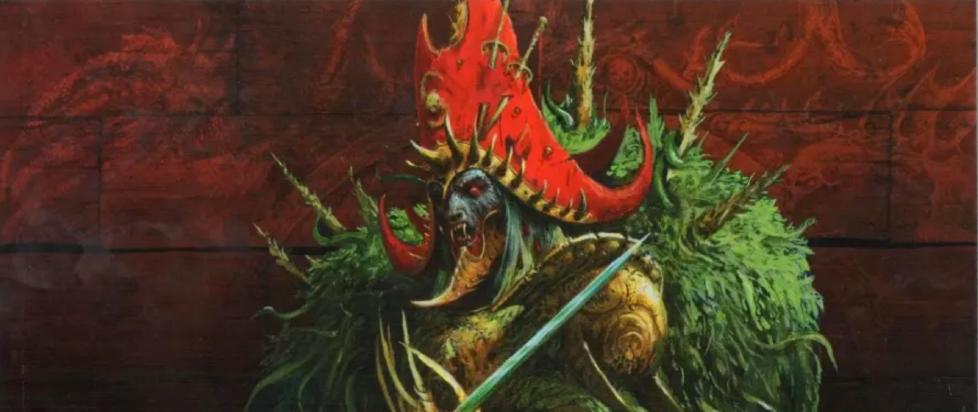
Blood and Plunder: Finding Lost Treasure (Though Maybe Not the Kind You Want) in Dreadfleet
I see board games in the store and they always look so cool and then I buy them and bring them home, I’m so excited to open them, and then I play them, like, twice… This column is dedicated to the love of games for those of us whose eyes may be bigger than our stomachs when it comes to playing, and the joy that we can all take from games, even if we don’t play them very often.
———
When I first got into Warhammer many, many years ago, there was a game called Man O’ War. It took place in the same setting as the classic Warhammer Fantasy Battles game but, instead of little fantasy army men, you pushed around little fantasy boats. These included little fantasy boats from all the same factions that populated the regular game, such as elves, dwarves, orcs, skaven, and so on. It also featured miniatures of various sea monsters, including a big crab, which I wanted desperately.
Like a lot of the games we’ve covered in this column that exist in the orbit around Warhammer and Warhammer 40,000, Man O’ War was not long for this world. The first edition was published in 1993 and, as far as I can tell, the last expansion came out in 1994.
While some of the games that were around when I was first getting into the hobby have since seen various new editions over the years – see our many columns concerning various iterations of Warhammer Quest – Man O’ War has remained steadfastly out of print… with one quasi exception.
In 2011, just a few years before the classic Warhammer Fantasy Battles game was phased out in favor of the first edition of the Age of Sigmar, Games Workshop released Dreadfleet, one of the last big boxed games to take place in what is now known as Warhammer’s “Old World.”
Dreadfleet isn’t exactly a new edition of Man O’ War, but it’s as close as we’ve ever gotten. Both games are fantasy simulators of naval combat, centered around miniatures of little metal or plastic ships. The primary difference is that Man O’ War was positioned as another full-on wargame, with players building out faction-specific fleets much as they would in classic Warhammer or Warhammer 40,000.

Dreadfleet, on the other hand, never had any such aspirations. It is, instead, a self-contained game, more like Space Hulk. There are two “factions” of pirate vessels, representing a mishmash of “good guy” and “bad guy” forces from the setting, including a dwarven steamship, an elven vessel accompanied by dragons, ships captained by vampires and mummies, and a skaven ship built inside the decaying corpse of a giant fish (for some reason), to name a few.
The game comes with unfortunately delicate miniatures of all these various ships (sails and rigging are hard to make sturdy in plastic, after all) as well as various island “terrain” for the boats to skirmish around. It even comes with a cloth mat to represent the water. Like all Warhammer-adjacent games, you’re meant to paint these various miniatures, which seems like maybe an even more than usually daunting task, given their many little sails and pennants.
The real treasure trove, where Dreadfleet is concerned, however, comes in the form of the rulebook. The book itself is sturdy and lengthy, clocking in at roughly 98 pages and featuring not only some finnicky (and, if reviews are to be believed, overly randomized) rules for naval combat, but also background on all the various players in this piratical conflict. Some of that is quite fun, but none of it is the really good stuff. The really good stuff comes as a result of the game’s moment in time.
Just as Dreadfleet is one of the last games released before Warhammer’s “Old World” became the “Mortal Realms” of Age of Sigmar, it is also one of the last gasps of an aesthetic style that had once defined the brand but was already on the way out. In this case, that comes predominantly from a number of illustrations and decorations by John Blanche, a name once practically synonymous with Warhammer.

For those who are unfamiliar, Blanche has an unmistakable style that helped to define the look of the various Warhammer worlds, and that style (along with several other complementary illustrators) is on full display throughout the Dreadfleet rulebook, including in large portraits of each of the various ship captains.
Though softcover, it is a rulebook which otherwise spares no expense. The pages are glossy, the illustrations heavy, the baroque stylings which defined the look of Warhammer at the time present throughout. It is a thing of beauty, as is the glossy, heavy-duty box in which the game is packaged. Just look at that cover!
Like most of the games which breach and then vanish in the oceans surrounding Games Workshop’s two flagship titles, Dreadfleet has been out of print now for many years. As befits its rather more limited promise, it produced no expansions or add-ons, as Man O’ War had before it. Instead, there is just this one box with its fiddly little ships and its glorious rulebook. And while I haven’t really dug into the gameplay enough to make a call one way or the other, by most accounts the game itself isn’t actually very good.
But as a time capsule and an objet d’art, it’s something to behold.
———
Orrin Grey is a writer, editor, game designer, and amateur film scholar who loves to write about monsters, movies, and monster movies. He’s the author of several spooky books, including How to See Ghosts & Other Figments. You can find him online at orringrey.com.





